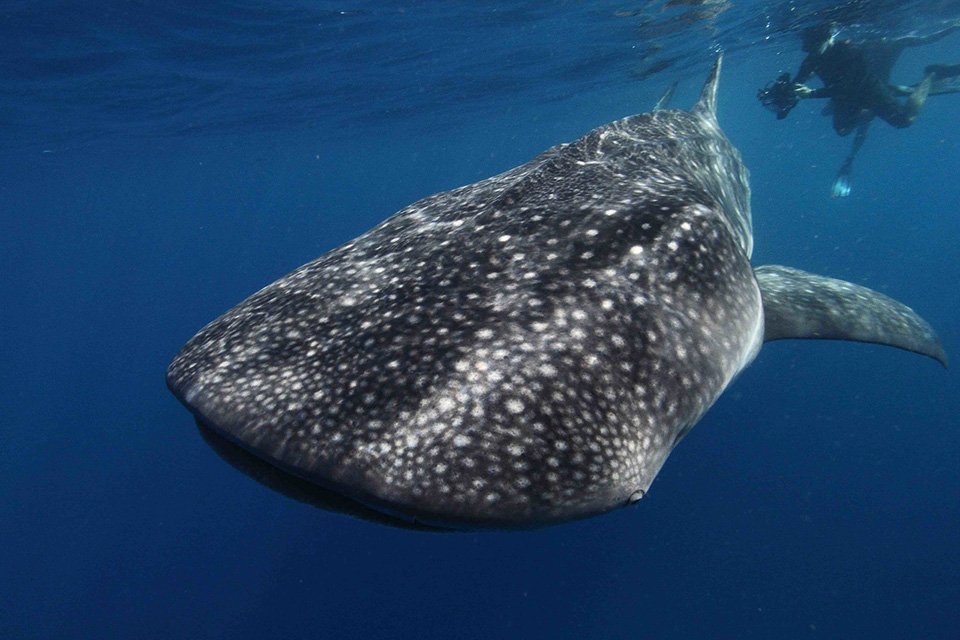
Distribution:
Found in tropical and warm-temperate seas worldwide,
typically seen in the tropics, such as the US territories,
but can be found as far north as Massachusetts.
They distributed globally and frequently sighted in regions
such as the Indian Ocean, the Western and Central
Pacific Ocean, and the Atlantic Ocean.
Ecosystem:
Whale sharks inhabit coastal and oceanic waters, often
found near the surface and in areas with high plankton
concentrations. They can be found around coral reefs,
at the edges of continental shelves and oceanic seamounts
like St Helena and Hawaii.
Feeding Habits:
Even though they have 3,000 teeny teeth, the biggest fish
in the sea feeds on the smallest prey are filter feeders,
consuming plankton, small fish, and fish eggs. They feed by
swimming with their mouths open or creating a giant suction,
gather food from the water as it passes through their gills.
Taxonomy:
Class: Family Rhincodontidae
Family: Order Orectolobiformes
Species: Class Chondrichthyes (cartilaginous fishes)
Overview and Physical Characteristics
Whale sharks are the largest sharks and the largest fish alive today. The largest confirmed whale shark measured 61.7 feet (18.8 meters) long. They have a broad flattened head with a large mouth located at the front of the head (rather than on the underside like most sharks) which they use to suck in mouthfuls of water they strain through special filter pads to capture their plankton prey. Whale sharks are identified by their dark gray skin and pale grey or white spots and stripes. Like fingerprints, the combination of spots and stripes is unique to each individual shark.
Distribution
Whale sharks are highly migratory, inhabiting all tropical and warm temperate waters of the world, except for the Mediterranean. They live along coastlines and in open waters, wherever dense planktonic concentrations can be found. Whale sharks migrate based on the availability of food, often following plankton blooms, fish spawning events, or seasonal changes in water temperature.
Ecosystem
Whale sharks play a crucial role in their ecosystem by maintaining a healthy balance in the marine environment. By consuming large quantities of plankton, small fish, and other microorganisms, whale sharks limit these species’ populations, helping prevent conditions that lead to a depletion of oxygen in the water. Whale shark waste provides essential nutrients such as nitrogen and phosphorus, which in turn promote the growth of phytoplankton, which forms the base of the marine food web.
Feeding Habits
Whale sharks are filter feeders. When they encounter a cloud of plankton, they swim through it with their large mouths open, allowing the water to pass through while capturing the plankton with specialized filter pads. While plankton is their main food source, they also feed on small fish, squid, and crustaceans and have even been known to suck down fish from fishermen in some parts of the world.
Observations suggest that whale shark feedings and aggregations can coincide with lunar cycles, particularly around full moons, due to the increased plankton activity during these times.
Behavior and Reproduction
Reproduction in whale sharks is still not fully understood. As primarily solitary creatures, they aggregate in large groups only occasionally. This occurs most often in areas with abundant food sources.
Due to their solitary nature, few details are known about their reproductive behaviors, including mating and birthing. they give birth to live young, a process which entails female sharks retaining fertilized eggs internally until they hatch. Other details however largely remain a mystery due to the difficulty of observing these massive creatures in the wild.
Whale Sharks and BOEM
Populations of whale (sharks have been in dramatic decline. To ensure that BOEM-authorized activities don’t contribute to this decline, this summer BOEM is collecting data on the spatial and behavioral ecology of whale sharks near offshore energy operations. Researchers will use satellite tags and sensors like accelerometers, (glorified Fitbits for fish) to gather information how they use their habitat, enabling us to recreate a day in the life of a whale shark long after they disappear from view. BOEM staff will synthesize data from this study with existing research to help determine potential risks to the species.
For more information on this study, visit: Mortality Risk for Whale and Basking Sharks During Energy Operations.
Fun Fact
Despite the reputation given to most sharks, whale sharks pose no threat to humans. These gentle giants, known to live for 60-100 years, allow swimmers and divers to approach them without engaging in any aggressive behavior. Swimming with whale sharks is a popular ecotourism activity, providing a unique opportunity to observe these large but docile creatures up close.
This story is part of the “Unleashing the Science” series, showcasing how bureaus within the Department of the Interior produce and apply science to ensure responsible management decisions for our planet now and for the future.
--BOEM--
The Department of the Interior’s Bureau of Ocean Energy Management (BOEM) manages development of U.S. Outer Continental Shelf (OCS) energy, mineral, and geological resources in an environmentally and economically responsible way.

